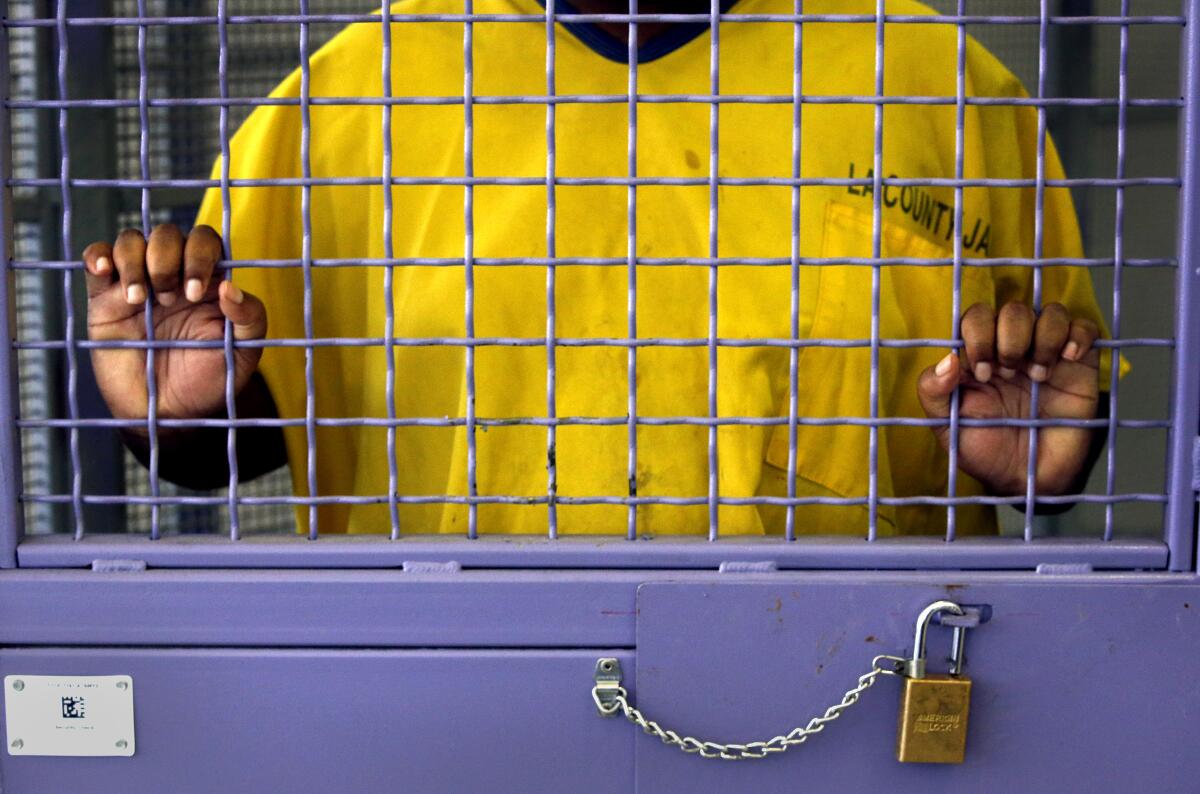Editorial: Treating mentally ill accused felons will save money and prevent new crimes

- Share via
The Los Angeles County jail is filled with hundreds of inmates accused of crimes but too mentally ill to understand the charges against them or assist in their own defense. Being incompetent to stand trial, they burn through county taxpayers’ money as they wait in jail.
Wait for what? Not to get completely and sustainably well, but just well enough to be fit for trial.
The improvement won’t happen by itself. Jail is a poor place for psychiatric treatment, and even though county clinicians do their best, the inmates’ condition often deteriorates, making future treatment even more difficult. Somewhat better results are achieved at the two treatment centers in San Bernardino and Kern counties and at state mental hospitals, and L.A. sends its mentally incompetent inmates to those places whenever beds open up. But the wait for those treatment slots can be a year or longer.
Then, if all goes well, the inmates go back to L.A. County, stand trial, and if found guilty generally end up back in jail or, if not guilty, on the street. In either case they’ll have no ongoing treatment plan, so they are destined to end up on the street and perhaps spin through the whole crime-jail-treatment-trial-crime cycle all over again.
In recent years the county developed a better way with its Office of Diversion and Reentry, more widely known as ODR. The office operates a program that moves people accused of misdemeanors — and some accused of felonies — from jail to community clinics for treatment until they are ready for court, and at a fraction of the cost of keeping them in jail. Whether or not they ultimately are found guilty, they leave with a care plan aimed at keeping them out of the otherwise endless cycle. That alone makes community treatment a better, more sustainable and less costly option than jail or state mental hospitals.
Now the state is looking for a handful of counties willing to divert not just some but all of their accused felons who are incompetent to stand trial (the bureaucratic lingo is “FISTs”). The state will pay. Los Angeles County ought to be first in line to sign up, because it has the largest and most costly FIST population, and in ODR the most nimble and accomplished local program for dealing with accused offenders with psychiatric conditions.
Besides, Los Angeles County government has moved itself to the cutting edge of treatment-based, sustainable alternatives to incarceration — at least in theory. In 2019, with great fanfare, the Board of Supervisors adopted a care-first jails-last program, voted to (eventually) close the dungeon-like Men’s Central Jail, scrapped a plan for a new treatment-based jail and agreed that treatment should take place in community clinics, with levels of security appropriate for the particular population housed in each. Last year voters amended the county charter to set a funding floor for community investment programs (such as youth development and job training) and alternatives to incarceration (with mental health treatment at the core).
Yet some in county government are now dragging their feet on the application to participate in the state program, known as the Community Care Demonstration Project.
The reasons for their resistance are exasperating. Some worry about setting loose a dangerous population — yet ODR already has a solid record of safely treating and housing accused felons, and it has community providers with space for the nearly 400 mentally incompetent ones currently waiting in county jail (and the 1,100 expected to pass through the jail over the course of the year). ODR vets would-be participants for likelihood of success, and mental health experts — and Superior Court judges — exclude accused rapists, murderers and others unsuitable for community treatment. And again, clinics offer security commensurate with the populations they house.
Some worry that the state isn’t providing enough money — yet the county stands not just to gain the operating funds offered by the state, but to recoup savings in the long run, because the cost of housing and treating a mentally incompetent inmate in the community is a fraction of the cost of housing and treating the same person in jail. Plus the county gains from connecting each participant with a community treatment plan, avoiding much of the future cost of new crimes and incarceration.
The state program is one response to a court ruling that the long wait times for state hospital placements violate the Constitution (an appeal is pending). The county ought to grab the chance to participate — to save money, to break the cycle of criminal recidivism and, by the way, to demonstrate that its promotion of alternatives to incarceration was more than just posturing.
More to Read
A cure for the common opinion
Get thought-provoking perspectives with our weekly newsletter.
You may occasionally receive promotional content from the Los Angeles Times.










